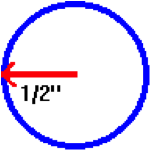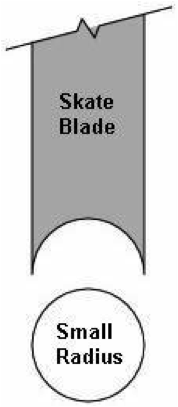Choosing an Appropriate Edge Radius When Sharpening Blades
It's been called a groove, a hollow grind, or a ground radius. You could refer to it as: "I want a 5/8" radius" or "I want a 1/2" radius". By grinding a radius into your skate blade you are making your edges sharp and depending upon the radius you choose, you are also making your edges more (or less) pronounced.
From grade school math, you may recall that a 1" diameter circle will have a 1/2" radius.


A 4" circle will have a 2" radius, a 3/4" diameter circle will have a 3/8" radius, etc, etc.
The diamond dresser attachment on most skate sharpening machines will dress (shape) the grinding face of the grinding wheel to the curvature shape of any radii between 1/4" and 1-1/4".This is the radius that will be transferred to the skate blade by grinding.
WHAT RADIUS IS BEST: THE MEANING OF "SHARP"
Choosing a radius can be as simple or as complex as you want to make it. The following discussion will allow you to understand skate sharpening. You should also be able to then form opinions on your own.
To begin , let's look at what different radii look like on the bottom of your blade. Note: These drawings are exaggerated for effect.
|
A SMALL RADIUS CREATES
"Deep Hollow"
|
||
|
A LARGE RADIUS CREATES
"Shallow Hollow"
|
|
After a skate has been ground it will have sharp edges regardless of how big or small the radius is. Keep in mind that the long speed skating blades used in the Olympics are honed flat with no radius. They are looking for maximum glide. While they are careful in the turns, don't ever doubt that these blade edges are not sharp! The real questions are: "Is there enough edge?" "Is there too much edge ?"
If immediately upon use a skater claims the skate is not sharp enough, they are usually saying, "this skate does not have enough edge on it to suit my skating".
How much edge a skater can tolerate is affected by four main variables. These are the skater’s weight, the skater’s discipline, the ice temperature, and the skater’s skill level.
Warning: in no case should a radius smaller than 1/4" be attempted. Besides being too sharp for anyone, this will weaken the sharpeners grinding wheel and will create a safety hazard.
WEIGHT
An extremely light skater can tolerate very small radii (producing a deep hollow and lots of edge). They do not have much weight to bear on the ice.
Beginner level skaters can learn most skills (particularly the hockey stop) easier by grinding their skates with a very large radius. As they progress the radii is decreased back to a normal level.
A heavy skater trying to skate on a small radius (too much edge) will bite into the ice so hard that they will have trouble stopping without chatter or going over the top of their skates. They will also loose glide to excess friction and be working harder. On the other hand, they will be able to hold a very tight turn!
Professionals and advanced level can skate on smaller radii , often finding it better for fast edging and footwork and better grip when landing higher rotation jumps; particularly effective for ice dancers. Skating on too small of a radius, sometimes feels like skating on soft ice.
While 3/8" radius edges are more pronounced than 5/8" they are also more fragile and less durable.
|
A "general purpose" chart for radius |
||||
|
COMPETITIVE/ICE DANCE |
INSTRUCTIONAL/BASIC HOCKEY |
BEGINNER |
RECREATIONAL |
HOCKEY GOALIE |
|
3/8"-7/16” |
1/2" |
5/8" |
3/4" |
1 TO 1 1/4" |
- A US Dime is ~11/16" in diameter or has an ~11/32" radius. This is ~1/32" less than a 3/8" radius.
- A US Penny is ~3/4" in diameter or has a ~3/8" radius
- A US Nickel is ~13/16" in diameter or has a ~13/32" radius. This is ~1/32" greater than a 3/8" radius.
- A US Quarter is ~15/16" in diameter or has a ~15/32" radius. This is ~1/32" less than a 1/2" radius.
SKATERS
Hockey: 1/2" seems to be the most common radius for kids through high school. Forwards generally prefer smaller radius than defense men of the same weight. Goalies generally prefer very large radius so that they can "kick out" without catching an edge.
Figure: Most beginner and instructional skaters can skate on a 1/2" radius. A 5/8" radius will take care of most recreational skaters.
When figure skaters get to the level where they are in a serious program, they will be under the guidance of a coach or instructor. The skater should consult these people for advice on the best radius for the program they are performing. Most common is 7/16” to 3/8” for ice dancers and in between for synchro
ICE TEMPERATURE
Most rink managers shoot for an ice temperature of approximately 25 degrees Fahrenheit. A temperature of 17 to 23 degrees is considered "hard hockey ice", 25 to 26 degrees is considered good figure skate ice. Slightly smaller radius may be used on colder/ harder ice and vice versa.
What causes Even and Uneven Edges
Skates needing to be sharpened do not just have dull edges; they will also have unevenly worn edges depending on weight distribution.
Skating: When skating aggressively, or with uneven weight distribution over the blade, typically caused by pronation, the inside edge is worn off more than the outside. Furthermore, the inside edge is worn mostly under the ball of the foot and not much at all near the tail of the skate blade. If you don’t believe this, go inline skating for a week and don’t rotate your wheels!
Improper sharpening: If the blade is not ground down along on the absolute middle of the skate blade it will always have uneven edges. There are two ways this can happen.
#1 The outside edge, which is higher, is therefore “sticking out” further than the inside edge and must contact the grinding wheel first. The high material will then be taken off and the grind will drop into the center producing even edges It's the center of the Blade that must be the guide, not the center of the worn radius. If this rule isn't followed, you get uneven edges. Qualified skate technicians will always use a small T-square or micrometer to measure the blade edges across the entire edge surface to make sure that they are exactly even. Years ago, sharpeners would be seen balancing a penny across the edges, which was close, but not exactly accurate.
#2 Skate blades are not all the same thickness. So the skate holder adjustments must be verified with every sharpening and not left at some arbitrary "standard" setting. If this rule isn't followed, you get uneven edges.
For more information about figure skating equipment, read our other guides or get in touch with us. We're always happy to help!


